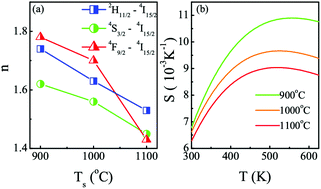当前位置:
X-MOL 学术
›
Dalton Trans.
›
论文详情
Our official English website, www.x-mol.net, welcomes your
feedback! (Note: you will need to create a separate account there.)
Up-conversion luminescence, thermometry, and optical heating properties of Er3+- and Yb3+-doped K2LaNb5O15 submicro-particles synthesized by a simple molten salt method
Dalton Transactions ( IF 3.5 ) Pub Date : 2018-07-04 00:00:00 , DOI: 10.1039/c8dt02069h Mengzhu Li 1, 2, 3, 4 , Yong Shi 1, 2, 3, 4 , Chuanzhen Zhao 4, 5, 6, 7 , Fengming Yang 1, 2, 3, 4 , Qiuyue Li 1, 2, 3, 4 , Xinxing Zhang 1, 2, 3, 4 , Shengcheng Wu 1, 2, 3, 4 , Haiyan Chen 1, 2, 3, 4 , Junming Liu 4, 8, 9, 10 , Tong Wei 1, 2, 3, 4, 11
Dalton Transactions ( IF 3.5 ) Pub Date : 2018-07-04 00:00:00 , DOI: 10.1039/c8dt02069h Mengzhu Li 1, 2, 3, 4 , Yong Shi 1, 2, 3, 4 , Chuanzhen Zhao 4, 5, 6, 7 , Fengming Yang 1, 2, 3, 4 , Qiuyue Li 1, 2, 3, 4 , Xinxing Zhang 1, 2, 3, 4 , Shengcheng Wu 1, 2, 3, 4 , Haiyan Chen 1, 2, 3, 4 , Junming Liu 4, 8, 9, 10 , Tong Wei 1, 2, 3, 4, 11
Affiliation

|
A series of Er3+- and Yb3+-doped K2LaNb5O15 (KLN:xEr3+/Yb3+) up-conversion (UC) submicro-particles have been synthesized for the first time by a simple and low-cost molten salt (MS) approach. X-ray diffraction (XRD) was performed to analyze the phase and structure, and the prepared KLN:xEr3+/Yb3+ samples exhibited a single phase tetragonal tungsten bronze (TTB) structure. The morphologies were characterized by scanning electron microscopy (SEM), and submicro-rod-like particles were obtained for all samples. Under 980 nm excitation, KLN:xEr3+/Yb3+ emitted bright green and weak red emissions which arose from the intra-4f transitions of Er3+ ions. The UC emission intensities and RR/G (the intensity ratio between red and green emissions) were disclosed to be tightly dependent on the Yb3+ ion concentration, and the involved UC luminescence mechanism was studied. Meanwhile, the slope of log I–log P plots displayed an evident reduction with a Ts (sintering temperature) increase, which was ascribed to the saturation effect coming from the competition between UC processes and linear decay. Furthermore, temperature-dependent UC behavior and temperature sensing properties of KLN:xEr3+/Yb3+ were probed based on the fluorescence intensity ratio (FIR) technique of UC green emission. The maximum sensor sensitivity (S) of KLN:0.04Er3+/Yb3+ (Ts = 900 °C) and KLN:0.16Er3+/Yb3+ (Ts = 900 °C) was determined to be as high as 10.90 × 10−3 and 12.27 × 10−3 K−1, respectively. We also showed that the particle size has an evident influence on S, which can be qualitatively interpreted by J–O theory. Thermal-cycling measurements were conducted at different temperatures, and good reliability and repeatability were confirmed. In addition, an obvious optical heating effect was also realized and the variation of temperature induced with a laser was about 32 K. These results reveal that KLN:xEr3+/Yb3+ submicroparticles with high sensor sensitivity and an obvious laser-induced thermal effect are suitable for future optical thermometers and optical heaters.
中文翻译:

简单熔融盐法合成的掺 Er 3+和Yb 3+的K 2 LaNb 5 O 15亚微粒的 上转换发光,测温和光学加热性能
通过简单的方法首次合成了一系列掺Er 3+和Yb 3+的K 2 LaNb 5 O 15(KLN:x Er 3+ / Yb 3+)上转换(UC)亚微粒。和低成本的熔融盐(MS)方法。进行X射线衍射(XRD)分析相和结构,制备的KLN:x Er 3+ / Yb 3+样品表现出单相四方钨青铜(TTB)结构。通过扫描电子显微镜(SEM)表征了形态,并且对于所有样品都获得了亚微棒状颗粒。在980 nm激发下,KLN:xEr 3+ / Yb 3+发出亮绿色和弱红色发射,这是由于Er 3+离子的内部4f跃迁引起的。公开了UC发射强度和R R / G(红色和绿色发射之间的强度比)与Yb 3+离子浓度紧密相关,并且研究了所涉及的UC发光机理。同时,log I –log P曲线的斜率 显示出随着T s的明显减小。(烧结温度)升高,这归因于UC过程和线性衰减之间的竞争所产生的饱和效应。此外,基于UC绿色发射的荧光强度比(FIR)技术,探索了KLN:x Er 3+ / Yb 3+的温度依赖性UC行为和温度感测特性。KLN:0.04Er 3+ / Yb 3+(T s = 900°C)和KLN:0.16Er 3+ / Yb 3+(T s = 900°C)的最大传感器灵敏度(S)确定为高达10.90×10 -3和12.27×10 -3 K-1。我们还表明,粒径对S有明显的影响,可以用J–O理论定性地解释。在不同温度下进行热循环测量,并确认了良好的可靠性和可重复性。此外,还实现了明显的光学加热效果,并且激光诱导的温度变化约为32K。这些结果表明,KLN: x Er 3+ / Yb 3+亚微粒具有较高的传感器灵敏度和明显的激光诱导热效应适用于未来的光学温度计和光学加热器。
更新日期:2018-07-04
中文翻译:

简单熔融盐法合成的掺 Er 3+和Yb 3+的K 2 LaNb 5 O 15亚微粒的 上转换发光,测温和光学加热性能
通过简单的方法首次合成了一系列掺Er 3+和Yb 3+的K 2 LaNb 5 O 15(KLN:x Er 3+ / Yb 3+)上转换(UC)亚微粒。和低成本的熔融盐(MS)方法。进行X射线衍射(XRD)分析相和结构,制备的KLN:x Er 3+ / Yb 3+样品表现出单相四方钨青铜(TTB)结构。通过扫描电子显微镜(SEM)表征了形态,并且对于所有样品都获得了亚微棒状颗粒。在980 nm激发下,KLN:xEr 3+ / Yb 3+发出亮绿色和弱红色发射,这是由于Er 3+离子的内部4f跃迁引起的。公开了UC发射强度和R R / G(红色和绿色发射之间的强度比)与Yb 3+离子浓度紧密相关,并且研究了所涉及的UC发光机理。同时,log I –log P曲线的斜率 显示出随着T s的明显减小。(烧结温度)升高,这归因于UC过程和线性衰减之间的竞争所产生的饱和效应。此外,基于UC绿色发射的荧光强度比(FIR)技术,探索了KLN:x Er 3+ / Yb 3+的温度依赖性UC行为和温度感测特性。KLN:0.04Er 3+ / Yb 3+(T s = 900°C)和KLN:0.16Er 3+ / Yb 3+(T s = 900°C)的最大传感器灵敏度(S)确定为高达10.90×10 -3和12.27×10 -3 K-1。我们还表明,粒径对S有明显的影响,可以用J–O理论定性地解释。在不同温度下进行热循环测量,并确认了良好的可靠性和可重复性。此外,还实现了明显的光学加热效果,并且激光诱导的温度变化约为32K。这些结果表明,KLN: x Er 3+ / Yb 3+亚微粒具有较高的传感器灵敏度和明显的激光诱导热效应适用于未来的光学温度计和光学加热器。











































 京公网安备 11010802027423号
京公网安备 11010802027423号